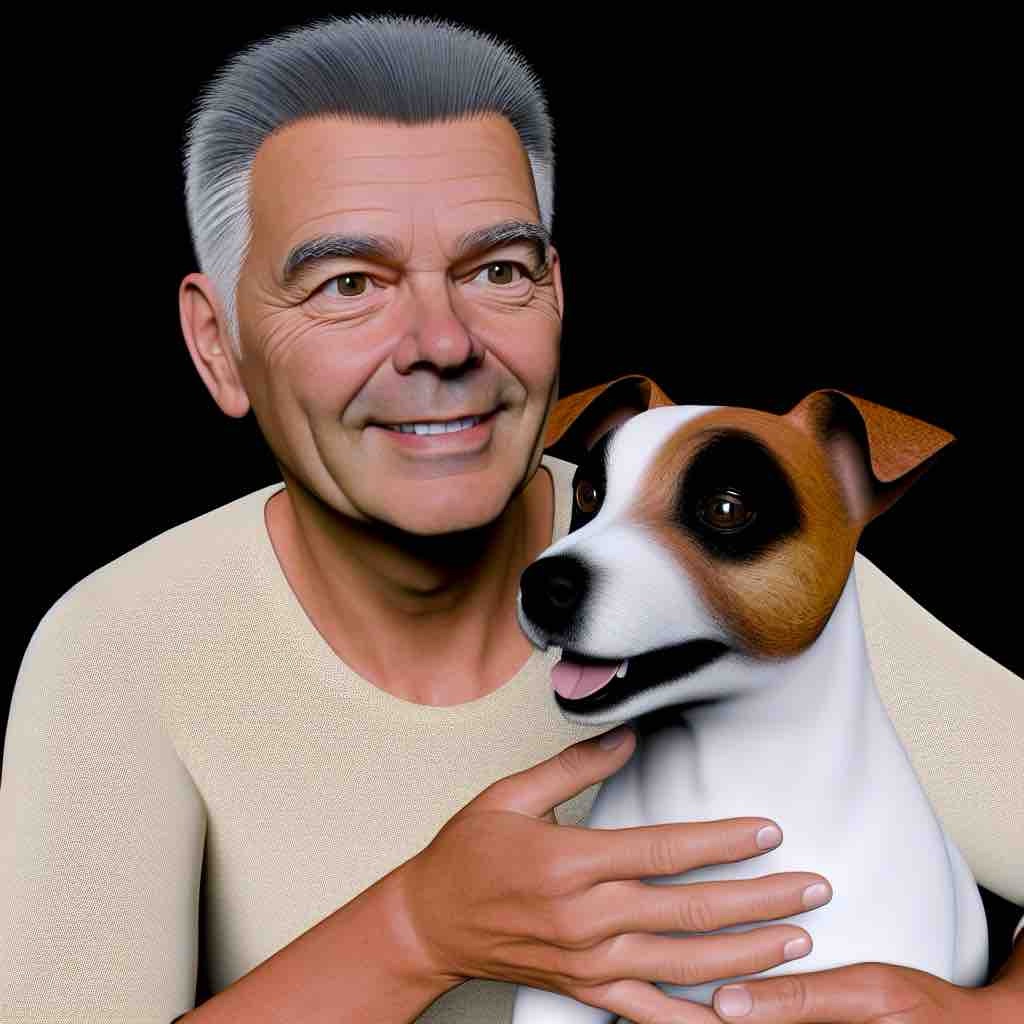The other day, I posted about image generation using AI. Today, I wanted to focus on one of those tools, DALL-E. This is a groundbreaking artificial intelligence system created by OpenAI, designed to generate images from textual descriptions. At the heart of its innovation is its ability to transform language into visuals, showcasing the potential of AI to blend creativity with computation. Through deep learning, DALL-E can produce diverse images, capturing the nuances of intricate prompts.

This AI model demonstrates the impressive capabilities of machine learning, extending beyond traditional image generation methods. Its ability to create images that didn’t exist before highlights a new frontier in digital artistry and content creation. OpenAI’s DALL-E is a reflection of the rapid advancement in AI technologies that are reshaping how creative processes are approached in today’s digital landscape.
Here’s an image I asked DALL-E to make of me and my dog. The prompt was, “Create an image of a middle aged white male with greying black straight short hair holding a jack Russell Terrier”.

To me, the image looks robotic and not quite right. By comparison, Microsoft’s AI tool, Copilot, drew a much more realistic image.

In spite of this, DALL-E draws attention not only for its artistic output but also for the conversation it sparks about the role of AI in creative industries. As AI models like DALL-E evolve, they challenge our perceptions of creativity and technology, offering a fascinating glimpse into the future possibilities of artificial intelligence.
Overview of DALL-E
DALL-E, a prominent generative AI model developed by OpenAI, specializes in creating images from textual descriptions. It leverages advanced machine learning techniques to interpret and visualize complex concepts, evolving across several versions.
Evolution of DALL-E Versions
The journey of DALL-E began with its first version, which introduced the capability of generating unique images based on textual prompts. The technology quickly drew attention for producing imaginative and sometimes surreal visuals.
DALL-E 2 enhanced this by improving the coherence of image outputs and expanding the range of styles and subjects. It achieved higher resolution images while maintaining lower computational demand.
DALL-E 3 focused on refining detail and articulation in images. This version integrated better with other applications and reduced limitations in capturing intricate prompts. It shows the model’s progression toward more sophisticated and realistic image generation.
Core Functionality
DALL-E’s core function involves using machine learning to understand and transform written prompts into visual art. The model employs a neural network trained on diverse datasets, allowing it to interpret linguistic nuances and apply them to image creation.
Key features include the ability to generate artwork across various styles, including photorealism, abstract art, and cartoons. Its interface supports ease of use despite the complexity underlying its generative processes.
By synthesizing text and image data, DALL-E leverages its AI capabilities to offer innovative tools for digital artists and content creators. This bridges the gap between imagination and visualization, showcasing the potential of artificial intelligence in creative fields.
Technical Foundations

DALL-E exhibits a sophisticated design rooted in neural network principles and leverages the capabilities of computer vision through its transformer architecture. Training and data processing play crucial roles in shaping its function and performance.
Architecture and Design
DALL-E utilizes a transformer architecture, a pivotal advancement in artificial intelligence. Originally developed for natural language processing, this structure efficiently handles sequences of data, even those inherent in images.
The architecture is distinguished by its attention mechanisms, allowing the model to focus on specific parts of input data to generate more accurate outputs. These mechanisms enable a deeper contextual understanding, important for generating complex images from text descriptions.
This neural network’s design incorporates multiple layers, each tasked with progressively refining the model’s ability to understand and generate images. The setup makes it possible for the model to process vast amounts of information quickly and accurately, a necessity for detailed image generation. These components work together to enable DALL-E’s capacity to transform textual descriptions into visual outputs.
Training and Data Processing
DALL-E’s capabilities are largely derived from extensive training on vast amounts of data. This encompasses both general and specific datasets, which help in teaching the model the nuances of image generation. The training data includes diverse linguistic and pictorial inputs to ensure versatility and robustness.
The process involves exposing the model to millions of text-image pairs. This helps the network build connections between textual concepts and their visual representations. By learning from these relationships, DALL-E becomes adept at synthesizing new images that align with given descriptions.
Data processing in this framework ensures that the inputs are organized and presented in a format suitable for training. These practices are crucial to enhance the model’s accuracy, ensuring that it can generate a wide range of precise and contextually accurate images.
Image Generation Capabilities
DALL-E is an advanced tool that can transform text prompts into high-quality images, enhancing creative workflows. This section explores its capabilities in generating visual representations from text and creating custom artwork.
From Text to Visual Representation
DALL-E provides the ability to generate images based on textual descriptions. It can turn simple or complex phrases into visuals, capturing minute details. The process involves interpreting keywords and phrases to produce images that align with the given descriptions.
The output images can range from abstract art to photorealistic generations, depending on input prompts. Realistic imagery is possible due to sophisticated algorithms that understand context and detail. This capability allows users to see a vivid representation of ideas that previously existed only in their imagination.
Custom Artwork and Design Elements
Beyond standard image generation, DALL-E’s system allows the creation of tailored artwork and design elements. Users can request specific styles, compositions, or themes, which DALL-E handles adeptly, offering personalized graphic solutions.
This tool’s flexibility in design supports various industries in producing unique visual content. Whether for marketing, education, or entertainment, its contribution is significant, allowing for images that meet specific visual requirements. By providing creative freedom, DALL-E expands the possibilities of digital art and design.
Innovative Uses in Various Fields

DALL-E is transforming how industries approach creativity and problem-solving, offering new opportunities to visualize concepts and enhance innovation across multiple domains. The technology’s impact ranges from creative arts to professional sectors like marketing and education.
Enhancing Creativity and Visualization
In creative fields, DALL-E supports artists and designers by providing a novel way to generate imagery based on specific descriptions. Artists can experiment with styles and concepts without traditional constraints, leading to unique and innovative artwork. Graphic designers benefit by quickly producing visuals for various projects, tailoring them to fit client needs or brand aesthetics.
In education, DALL-E aids in illustrating complex ideas or bringing abstract concepts to life. It serves as a tool for both teachers and students, allowing enhanced comprehension and engagement. Content creators leverage this technology to produce eye-catching and relevant visuals for digital media, enriching audience interaction and storytelling.
Practical Applications in Industry
Marketers use DALL-E to generate customized marketing materials that stand out. By creating diverse visuals tailored to target audiences, they can improve campaign effectiveness and brand recognition. This tool allows for rapid iteration and testing of visual content, leading to more agile marketing strategies.
In industry settings, the tool assists in product design by visualizing prototypes or new concepts swiftly. This capability enhances innovation in sectors like consumer goods or automotive design, facilitating informed decisions without the need for costly physical models. These practical applications highlight DALL-E’s role in driving progress and efficiency across various fields.
Integration and Accessibility

DALL-E’s integration prioritizes user accessibility, allowing seamless use of its AI system. It offers a user-friendly experience, emphasizing customization and interaction. Let’s explore its ease of use and user interface design to understand how it facilitates a broad audience.
Ease of Use and Customization
DALL-E’s intuitive design makes prompt engineering straightforward, enabling users without technical expertise to engage with its text-to-image model. Users can input simple or complex prompts and receive high-quality images in response. The platform supports customization to cater to specific needs, enhancing user interaction and creativity.
Options for adjusting parameters allow users to refine the output, ensuring results align with their expectations. Additionally, tutorials and guides are available to help new users navigate the system efficiently.
User Interface and Experience
The user interface of DALL-E is streamlined and intuitive, enhancing accessibility for all users. Clearly labeled menus and controls contribute to an easy-to-navigate environment. This design reduces the learning curve, allowing users to focus more on the creative process.
Visual feedback is incorporated to guide users through each step, making interactions with the AI system a fluid experience. The interface is also responsive to varying devices, ensuring accessibility across multiple platforms. Whether accessed on a desktop or mobile device, DALL-E maintains functionality and ease of use, supporting a wide range of user preferences and needs.
Ethical Considerations and Safety Measures

Artificial intelligence like DALL-E can be powerful but also presents unique challenges. Important factors include reducing potential harm, such as misuse, and implementing careful content moderation strategies to ensure safety and compliance with policy guidelines.
Mitigating Potential for Harm
AI systems can be misused in various ways. DALL-E includes safety measures to reduce risks, such as safeguards against generating explicit content. Misuse is a significant concern; therefore, the team enforces strict content policies.
AI-generated content involves intellectual property issues. Developers need to ensure that creations do not infringe on the rights of others. Clear guidelines help navigate these legalities. Human monitoring plays a role in mitigating these risks, as human reviewers assess AI outputs to identify and resolve potentially harmful or inappropriate content.
Content Moderation Strategies
Content moderation strategies include a mix of automated and human oversight. Explicit content filters are deployed to block inappropriate outputs, maintaining a standard suitable for diverse user bases.
Moderation policies are regularly updated to account for evolving AI capabilities and emerging risks. Human moderators review flagged content, ensuring the system operates within ethical guidelines. This oversight prevents potential misuse and upholds the integrity of the AI’s output in accordance with content policy.
To ensure safety, the strategies are designed to balance creativity and ethical standards effectively. This ongoing approach reflects a commitment to improving AI’s impact responsibly.
Advantages and Limitations

Exploring the strengths and weaknesses of DALL-E reveals insights into its technical capabilities and creative possibilities. Analysis of its limitations enables better predictions about its future growth.
Technical and Creative Boundaries
DALL-E demonstrates impressive efficiency and speed, translating text prompts into vivid images with remarkable detail.
Its ability to interpret and follow complex instructions allows for significant creativity in outputs. Despite these strengths, certain limitations exist. Unpredictability in reproducing specific artistic styles can pose challenges for consistent results. While DALL-E excels in generating abstract concepts, more nuanced artistic subtleties may require human intervention.
The model also faces difficulties with fine details and maintaining coherence in all areas of an image.
Future Potential and Growth
The future of DALL-E holds promise for refined capabilities and broader applications. As technology evolves, improvements in prediction algorithms could enhance its ability to maintain consistency and add intricate details, addressing current limitations.
Further development may streamline the model’s efficiency, possibly integrating it into diverse creative industries. Speculation about its growth includes collaboration with other AI technologies, potentially boosting its speed and reliability.
Ongoing research and innovation are likely to expand its utility, pushing the boundaries of what DALL-E can achieve, making it a vital tool in creative fields.
Comparative Analysis of AI Art Generators
AI art generation has evolved significantly, with various tools offering unique capabilities. Comparing DALL-E with its alternatives sheds light on the different approaches and innovations each platform brings to the table.
Benchmarking DALL-E Against Competitors
DALL-E, developed by OpenAI, utilizes a Generative Pre-trained Transformer (GPT) model to create intricate images based on textual prompts. It is known for its ability to generate realistic and diverse visual content.
Midjourney and Stable Diffusion are notable alternatives. Midjourney is recognized for its artistic, surreal style. It excels in producing visually striking artworks that lean towards abstraction. In contrast, Stable Diffusion focuses on high-quality image synthesis, emphasizing stability and continuity in generated art.
Other AI art creators also employ deep learning methods, but each has unique algorithms and focuses that influence their output style and quality. The choice of the underlying model, such as the Diffusion Model used by some, affects the visual characteristics and capabilities of the art generator.
Market Positioning and Unique Value Proposition
DALL-E’s market positioning revolves around its versatility and accessibility, offering users an intuitive interface and robust image generation capabilities. It targets a wide range of users, from casual creators to professional designers, by enabling the creation of detailed and varied images.
On the other hand, Midjourney and Stable Diffusion position themselves by emphasizing their specialized styles. Midjourney appeals to users seeking artistic and ethereal outputs, while Stable Diffusion targets those in need of consistency and quality across produced images.
These platforms differentiate themselves through unique value propositions. While DALL-E is celebrated for its innovation in text-to-image synthesis, Midjourney and Stable Diffusion offer niche advantages in stylistic flexibility and image fidelity.
